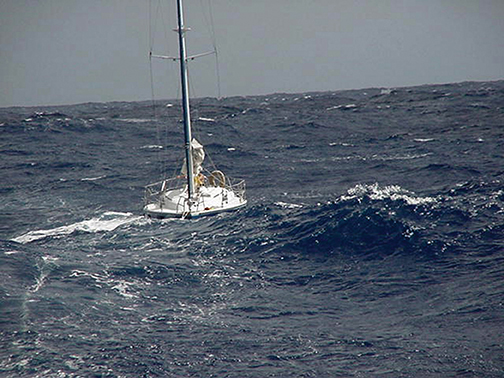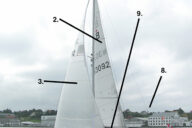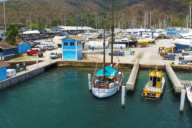With enough time and miles at sea, encountering problems and equipment failures is inevitable. Having the original equipment manufacturers’ authorized spares and repair kits onboard is not. Regardless of those mutually exclusive constraints, getting home safely is still your responsibility (published in BWS in May 2016, by Bill Biewenga)
After years of rigorous training and practice, Peter Bourke was about start his first OSTAR. Part of that training was the just completed delivery to England with which I had assisted. After a day in Plymouth, it was time for me to bid Peter farewell and good luck.
“Of course you’re going to run into problems and equipment failures along the way back home Peter,” I said “But all you’ll really need is some kind of rig above you, some rags to hang up there, and a watertight hull below you. The rest is luxury.”
Upon reflection those words may not have seemed like they offered much reassurance. But knowing that Peter had also spent part of his distant past in the U.S. Marine Corps, I felt that he could appreciate the twisted humor as well as the rudimentary insights. If equipment failed, he would either fix it or learn to do without it, and I’ve learned that when offshore, there are precious few things you can’t really do without. When extreme circumstances arise in which those precious few things are compromised however, you better be ready to fix them—one way or another.
Boiled down to the basic elements, when sailing long distances, you need to know where you are, where you’re heading and have the means to do it. Pinpoint accuracy may not be necessary, especially when mid-ocean, and speed isn’t always a requirement. If you have any doubt about that, you can read Steve Callahan’s book, Adrift. Jury rigging does, however have a few requirements; innovation, open-mindedness, perseverance and common sense will ultimately serve you well. A few tools or basic kits will also help in a variety of jury rigging scenarios.
If we break down major critical elements of sailing from Point A to Point B into navigation, sails, rigging, and hull, we might want to add steering and life-sustaining elements like food, water and shelter or clothing. Having an emergency backup system for navigation is pretty straightforward; stow a couple of handheld GPS systems with plenty of dry spare batteries. Keep them in a safe place, protected from the elements including the potential for a lightning strike. If the devices and batteries are stowed in a rubber or insulated container, you should be good to go. If that device can plug into a laptop computer, you may be able to use resident navigational software that you already have and save yourself a lot of time and effort. You will also want to have overview and detailed paper charts of your destination and a few alternate stopping points. I now find that backup for communications can easily be had by getting an InReach tracking and messaging device and signing up for unlimited messaging. If I have to jury rig my communications and let people know my arrival will be late, InReach is currently my preferred method.
Jury rigging sails together can be a bit more problematic than merely reaching for a handheld device. You may actually need to do a little sewing or perhaps putting enough sticky-backed Dacron on a torn spinnaker to get it back into operation. It’s not that difficult, but it does require—or at least suggest—that you will want to have a good sail repair kit available onboard. For extended passages, I fill a small duffle bag with the itens in the following table.
In addition to the above items you might also include hardware such as spare slugs for the mainsail, spare hanks or climbers’ carabiners for use in a hank-on headsail or other types of hardware that you use in conjunction with your sail inventory, such as shackles for tack and head fittings or high tensile line to be used in lieu of bolt rope.
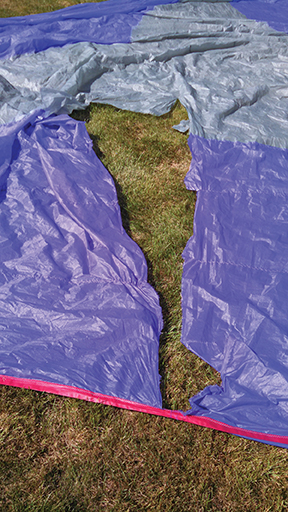
Few boats carry such an extensive sail repair kit. Eventually, many wish they had. And, in fact, I’ve used every item mentioned above at one time or another, happy to have the right repair equipment available. In a worst case scenario, you can even use duct tape or even 5200 marine adhesive (ugh!) to piece your sails back together again like Humpty Dumpty, but don’t tell anyone I suggested such low tech and repulsive solutions. The point is that if your life and vessel depend on getting home, there are ways to accomplish that mission that go well beyond the manufacturers’ suggest methods.
Rigging problems that may require a juried rig come in a wide variety of flavors. Is the mast over the side or merely down? Is the standing rigging in one piece or broken? Is any of it salvageable? Is your boom intact? In other words, you need to assess your situation, taking all of your assets into consideration. From there, you need to make a plan and get to work. Virtually all of your rigging is heavy, and to move things around or make repairs, I find that having a heavy duty block and tackle, a long piece of stout Spectra line—perhaps an old halyard—and several high capacity snatch blocks will go a long way in making repairs or moving things that are otherwise too heavy for me to handle.
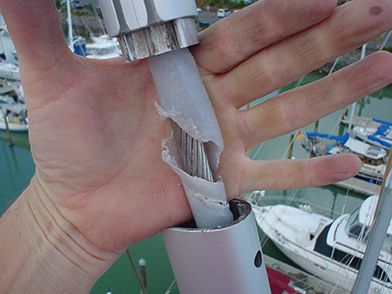
Rigs that are down can be re-righted, even if it’s only using part of the old rig. Ceramco New Zealand did that during the 1981 Whitbread Round the World Race and used the boom as a mizzen mast. After re-cutting and re-hoisting their sails, they were able to achieve a 250 mile day’s run. Using a doubled length of Spectra to replace a broken cap shroud and a block and tackle run to a winch to tension the replacement, I’ve been able to complete 600 mile passages—twice, due to similar failures on separate occasions. Jury rigs work if they’re strong enough and you’re conservative enough when you’re back underway. In the 1985 Whitbread Atlantic Privateer dropped their rig and stopped in Lüderitz, a few hundred miles north of Cape Town, South Africa. They replaced the mast with a length of PVC sewer pipe.
Thinking outside of the box is allowed when considering jury rigged solutions, but strength and a conservative approach will help to increase the likelihood of success. In another situation, an “A” frame was erected on Warren Luhrs’ entry in the 1986 BOC Singlehanded Round the World Race, Thursday Child to serve as a jury rig using two spinnaker poles for the legs of the “A” and old halyards for the head and back stays. Several months later, John Hughes in the same race, used a similar solution for his jury rig following a dismasting in the eastern South Pacific. Subsequently, he sailed with the jury rig around Cape Horn and up to Rio de Janeiro, Brazil. Jury rigs can work, and you CAN get yourself, your crew and your vessel back home. Having a watertight hull will help. Hulls want to fill up with water—at least up to the waterline. It’s your job to keep that water out. It may want to come in through a thru hull fitting or a smashed porthole, a hole created at the base of a fatigued prop strut or one created in a collision. Regardless of the source of the water, it’s your job to keep it out.
In some cases wooden bungs will quickly solve the problem if the hole is circular such as a speedo thru hull. Wooden bungs work best when they are surrounded in cotton such as an old cotton tee shirt or piece of cotton string. Cotton, unlike synthetic material, will absorb water and swell to fit the hole, thereby cutting off the supply of water. Having a few cotton tee shirts around or some cotton string in your pocket may be just the ticket to solve your problem. Larger holes may require something else. Onboard Great American II, when Rich Wilson and I set the San Francisco to Boston and New York to Melbourne, Australia records, we had a three x four foot sheet of three ply fiberglass made for us. It was flexible enough to stow against any bulkhead and didn’t take up much space. We also carried a couple of tubes of 5200 marine adhesive which will kick off in the presence of salt water and a bag of stainless steel self-tapping screws. If we were holed, we could attach a storm sail over the side to try to limit the amount of water entering the boat and inside the boat we could run a couple of beads of 5200 around the hole, placing the fiberglass patch over the hole and 5200 and secure the patch with the self-tapping screws. It wouldn’t be pretty, but it could serve as a base upon which we could build layers of fiberglass and resin to further reinforce the patch. Alternatively, we could pile sails or bedding against the patch and hold the water back. On Drum during the 1985 Whitbread Round the World Race, we had to do a similar reinforcing job when the Nomex core sheered inside the composite in the forward section of the boat. The hull was flexing like an under-inflated dinghy, and several four foot holes were about to open up in the bow. The temporary bracing was enough to hold the weakened composite together and keep us afloat for 500 miles.
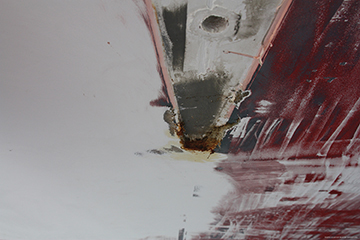
Ultimately, if and when the water gets into the boat, it now becomes your responsibility to get it out.Automatic pumps work great—usually. Emergency pumps work great, as well—usually and especially if they’re properly maintained, the rubber bellows isn’t rotten and they have sufficient capacity to offset the inflow of the water. But there can be times when neither of those means is available or sufficient. If your engine is able to work, you may be able to close the raw water intake, fit a hose into the cooling water intake hose and use the engine to pump out the bilge in lieu of drawing water from outside the boat to cool the engine. It would be a good idea to have a clean bilge, because it wouldn’t be very helpful if a matchstick or other litter was sucked up into the engine’s cooling system at a time like that. Having a few hoses of varying diameters and sufficient length to get to the bilge sump might be a jury rig that keeps you afloat. It has for me—twice.
Of course, now that you know where you are located, have some kind of stick on which to hang some rags and have at least most of the water out of the boat, you probably want to set a course towards home—or perhaps a nearby place to take a break. Being able to steer your boat would be a definite plus, and most of the time the wheel, chain, sheaves, cable, quadrant, rudder stock and rudder will help with that task. Not always. If you’re not already relying on a hydraulic system with pumps, fluid, seals and other gadgets, you might be able to try your autopilot as a steering backup. In most cases, that’s your first line of defense. Not always. It may come down to dragging warps behind the boat or a Gale Rider. In either case, you will want to be familiar with the process. It’s easy enough, and in the case of warps, if you have dock lines with you, you have all you need. Setting them up can be easy, and if you favor one side of the wake over the other, the warps will steer you in the direction you want to go. Friends of mine have used that system for hundreds of miles and got where they were going.
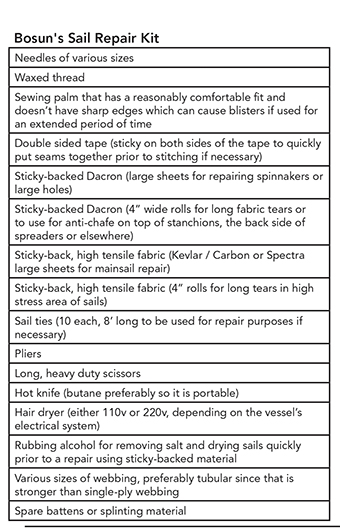 Of course good preparation, proper tool kits, sail repair kits and spare engine parts make things easier. Engines are a luxury and really not necessary to get where you’re going, but if you really require a fuel filter replacement or are out of lube oil and don’t have any, you’ll find that you’ll soon be jury rigging a lot of other things, primarily those items that rely upon electricity to work. As I mentioned to Peter, prior to departing from England, all you really need is a hull to keep the water out and some kind of a rig on which to hang some rags. The rest is luxury. And I’m certainly in favor of that!
Of course good preparation, proper tool kits, sail repair kits and spare engine parts make things easier. Engines are a luxury and really not necessary to get where you’re going, but if you really require a fuel filter replacement or are out of lube oil and don’t have any, you’ll find that you’ll soon be jury rigging a lot of other things, primarily those items that rely upon electricity to work. As I mentioned to Peter, prior to departing from England, all you really need is a hull to keep the water out and some kind of a rig on which to hang some rags. The rest is luxury. And I’m certainly in favor of that!
Bill Biewenga is a navigator, delivery skipper and weather router. His websites are www.weather4sailors.com and www.WxAdvantage.com. He can be contacted at billbiewenga@cox.net

